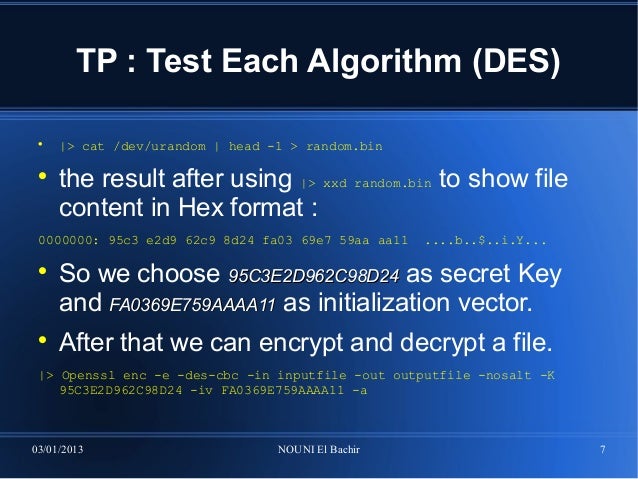Openssl Generate Key And Iv
Symmetic encryption
For symmetic encryption, you can use the following:
To encrypt:
Generate an AES key plus Initialization vector (iv) with openssl and; how to encode/decode a file with the generated key/iv pair; Note: AES is a symmetric-key algorithm which means it uses the same key during encryption/decryption. Generating key/iv pair. We want to generate a 256-bit key and use Cipher Block Chaining (CBC). May 30, 2017 书接上回。在《ldap 密码加密方式初探》一文中,使用 openssl 命令 aes 算法加密解密时,都用到了 key 和 iv 参数,那么这两个参数是如何生成的呢? 仍然以 aes-256-cbc 开始探.
To decrypt:
Asymmetric encryption
For Asymmetric encryption you must first generate your private key and extract the public key. /github-generate-ssh-deploy-key.html.
To encrypt:
To decrypt:
Encripting files
You can't directly encrypt a large file using rsautl. Instead, do the following:
- Generate a key using
openssl rand, e.g.openssl rand 32 -out keyfile. - Encrypt the key file using
openssl rsautl. - Encrypt the data using
openssl enc, using the generated key from step 1. - Package the encrypted key file with the encrypted data. The recipient will need to decrypt the key with their private key, then decrypt the data with the resulting key.
Ultimate solution for safe and high secured encode anyone file in OpenSSL and command-line:
Openssl Generate Key And Iv 2
Private key generation (encrypted private key):
With unecrypted private key:
Microsoft windows 7 ultimate key generator. With encrypted private key:
Openssl Generate Key And Ivy
With existing encrypted (unecrypted) private key:
Encrypt a file
Openssl Generate Key And Iv Free
Encrypt binary file:
Encrypt text file:
What is what:
smime— ssl command for S/MIME utility (smime(1)).-encrypt— chosen method for file process.-binary— use safe file process. Normally the input message is converted to 'canonical' format as required by the S/MIME specification, this switch disable it. It is necessary for all binary files (like a images, sounds, ZIP archives).-aes-256-cbc— chosen cipher AES in 256 bit for encryption (strong). If not specified 40 bit RC2 is used (very weak). (Supported ciphers).-in plainfile.zip— input file name.-out encrypted.zip.enc— output file name.-outform DER— encode output file as binary. If is not specified, file is encoded by base64 and file size will be increased by 30%.yourSslCertificate.pem— file name of your certificate's. That should be in PEM format.
That command can very effectively a strongly encrypt any file regardless of its size or format.
Decrypt a file

Decrypt binary file:
For text files:
What is what:
-inform DER— same as-outformabove.-inkey private.key— file name of your private key. That should be in PEM format and can be encrypted by password.-passin pass:your_password— (optional) your password for private key encrypt.
Verification
Creating a signed digest of a file:
Verify a signed digest: